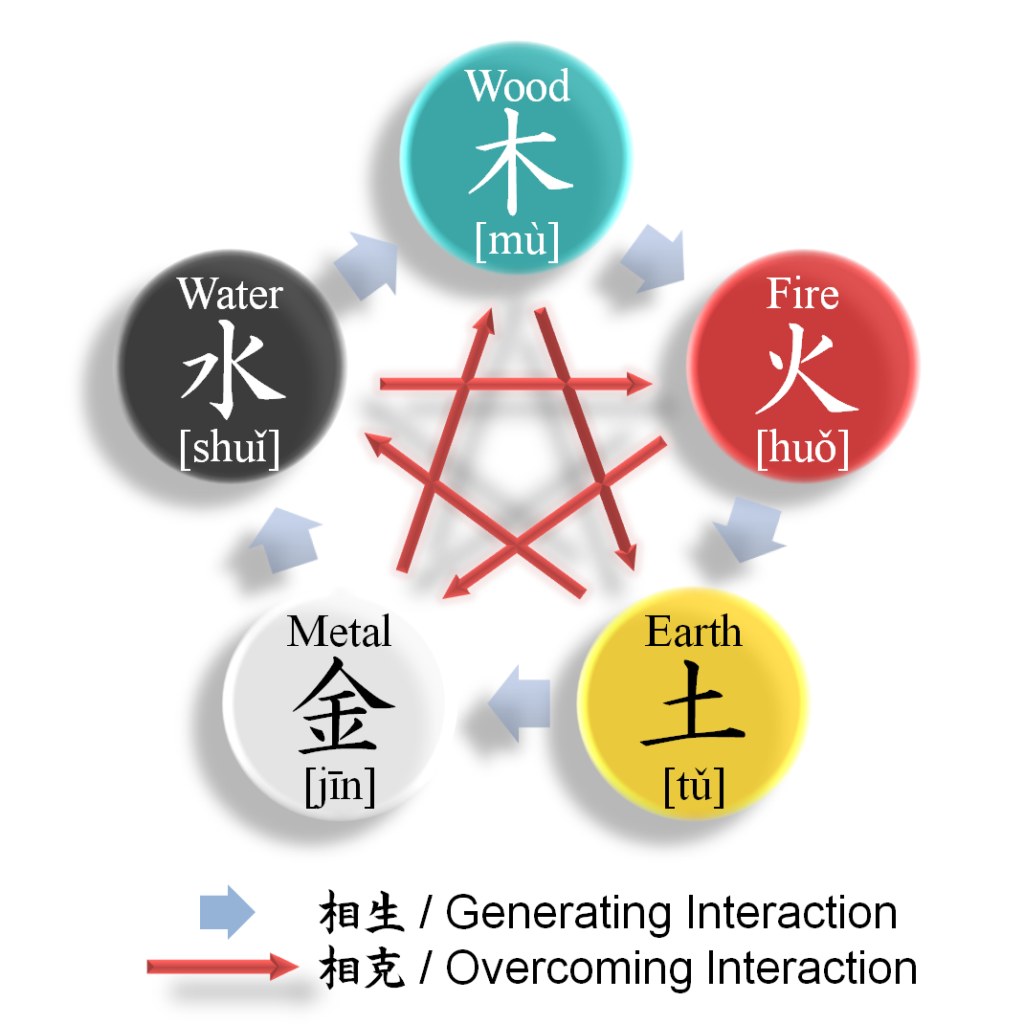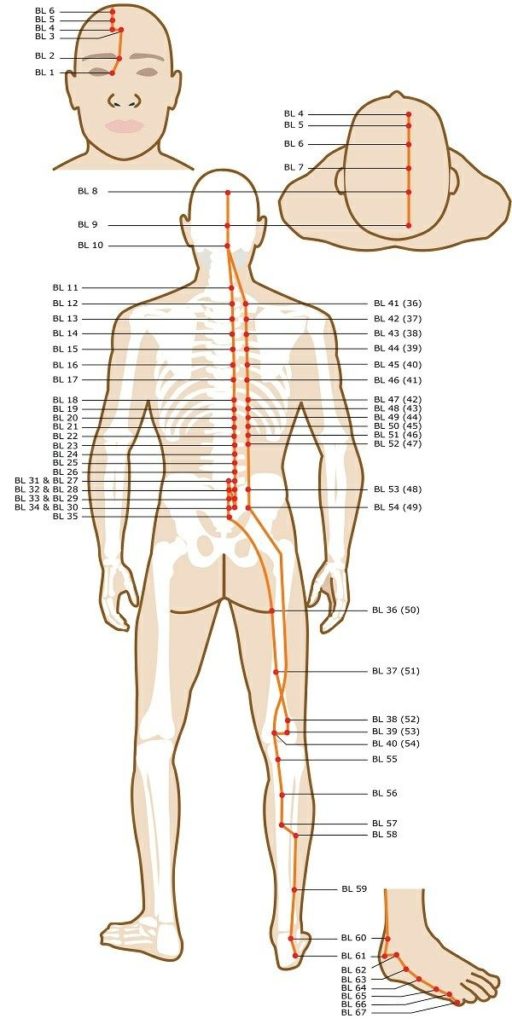The Water Element of Feng Shui & East Asian Medicine is the most yin of all elements. Hence, it contains the most darkness, beginning at Winter Solstice, the shortest day of the year. Wisdom from Chinese Medicine guides how to cleanse your whole being, attuned to the seasonal cycles. In East Asian Medicine, winter corresponds with the bladder and kidneys, recommending this as the best time to tune-up these organs. It’s also a good time to detoxify the mind and body’s toxic residue from fears. Fear-based emotional patterns correspond with the water element and winter season.
Five Elements of East Asian Medicine & Feng Shui

East Asian Medicine rests on a foundation of 5 Element Theory, involving Wood, Fire, Earth, Metal and Water. Even more, these elements are a 5-phase theory of interrelated, organic energies expressed in our body and nature. For instance, this pentagram within hosts a flow of energies that depict our personalities, emotions and health imbalances. Furthermore, everyone has their unique energetic blueprint of 5 elements expressed through health patterns, and this can be a key factor in diagnosing for a East Asian Medicine Practitioner. This article is part of a 5-element series, focusing on the water element for winter. Overall, this table sums up all elements and their correspondences:
Table of Elements and Correspondences:

The interrelationships follow a flow in which each element feeds the next element and controls the second from it as depicted below. For example, Water engenders Wood and controls Fire and so on. And Water is engendered by Metal controlled by Earth. We embody all five elements, however, many individuals express certain elements more strongly. For example, a water type when in balance will face their fears, staying determined with willpower to overcome obstacles and follow through on their intentions. If the water type is out of balance, furthermore, s/he be fearful and lack courage or overwork leaving the body out of balance with symptoms like arthritis, edema, dark circles under the eyes or hearing problems.
Water Archetype of Bladder/Kidney

The water element archetype is one of the 5 used in East Asian Medicine diagnosis, embodying the physical, mental and spiritual aspects of the constitution. Being human, we are always out of balance with our own individual blueprints toward our highest nature. Working with and understanding the baseline can give guidance for objective assessments, helping to eliminate judgement and encouraging personal evolution.
The water element in East Asian Medicine Astrology is yin energy, as the last zodiac sign of the year in winter: Pig and rat. Water’s symbol is the Black Tortoise and its direction is North. Water types often have round faces and roundish body types with dark hair and soft eyes. These people represent the adage: still waters run deep and they can be more contemplative and go with the flow in life, needing to rejuvenate through solitude and tranquility. If they overwork and try to force their work, they feel fatigued, showing dark circles under eyes or develop arthritis or water retention.
Each element associates with paired yin-yang organs and other emotions.
The paired yin-yang organs for the Water Element are the Kidneys (Yin) and Bladder (Yang). East Asian Medicine’s cultural perspective is different than the Western world regarding emotions. With the exception of joy, from the western perspective, the other 4 TCM emotions of anger, worry, grief and fear are considered ‘negative’ to most individuals.
In East Asian Medicine, however, emotions are a source of disharmony with neutral connotations. All emotions have their place in healthy individuals and should be expressed in a balanced way to maintain health. Even too much joy can be a source of disharmony. The emotion fear associates with Water and these personality types are learning to face their fears and develop courage to overcome obstacles.
Taoist Healing Sounds & Tones / Transforming Fear
In East Asian Medicine, there’s an ancient Taoist concept of the Six Healing Sounds or Liu Zi Jue. Each of the 5 elements and paired organs have a healing sound and tone. Triple Burner is the sixth sound, integrating the other 5 sounds and is explained in Fire Element blog. The tone for Water element is A and the healing sound is WOOOO. There is a Taoist Qi Gong exercise where you lean forward, with hands over the Kidney area, inhaling deeply into these organs then exhaling while saying the healing sound, WOOOO. Overall, the Six Healing Sounds transform the stagnant energy stored in the organs and meridian pathways into a vital life force.
Also, this includes an exercise, similar to the western modality, EMDR (Eye Movement Desensitization Reprogramming). During the Kidney exercise, you imagine a person or situation that has given you fear (If it involves a person, separate the person from the fear). Next, imagine both eyes moving down, to your Kidneys. While focusing on the fear, move your eyes back and forth, and imagine the eyes in your Kidneys moving back and forth, eliminating the fear. This exercise is practiced with all organs and their corresponding emotion and vocal healing sounds. In addition, you can use color therapy and imagine vibrant blue/black light penetrating the Kidneys during this meditation.
Bladder/Kidney Meridian Therapy
In East Asian Medicine, the 12 principle meridians correspond with 6 paired organs, 1 yang/hollow and 1 yin (solid) pairs for each element. Fire Element is an exception, having 2 pairs. Meridians are channels, where the qi (life force) flows, transforming energy to material and vice versa. Also, the acupuncture points are along these channels as location for needling.
However, there are many ways to stimulate the points without acupuncture needles, using essential oils, acupressure, massage, Reiki or tuning forks. Plus, anyone can support the flow of the qi in the meridians by stretching or doing yoga. When we are stiff, for example, our meridians kink like a garden hose, obstructing our free flow of qi. Furthermore, obstructions lead to pain or disease from this imbalance.
Kidney & Bladder Meridians with Powerpoints
Bladder Meridian:

2-“Collecting Bamboo,” medial extremity of eyebrow-conjunctivitis, sinus allergies, tearing
10-“Heaven Pillar,” on neck, the lateral aspect of trapezius-common cold, neck and back pain
11-“Great Shuttle Bones,” 1.5 cun from spine, level with T1-nourishes bones, and also common cold
13-“Lung Shu,” cough, asthma, chest pain, spitting blood
15-Heart Shu-1.5 cun from spine, level with T5-cardiac pain, palpitation, memory loss and also calm mind
17-Diaphragm Shu-1.5 cun from spine, level with T7-diaphragm spasms, hiccups, hepatitis, vomiting
18-“Liver Shu,” 1.5 cun from spine, level with T9-hepatitis, jaundice, gastritis and also bitter taste
19-“Galbladder Shu,” 1.5 cun from spine, level with T10-jaundice
20-“Spleen Shu,” 1.5 cun from spine, level with T11-nervous vomiting, gastritis, prolapsed stomach
21-“Stomach Shu,” 1.5 cun from spine, level with T12-gastric distention, anorexia, diarrhea, nausea
23-“Kidney Shu,” 1.5 cun from spine, level with L2-Low back pain, impotence, menstrual issues, diarrhea, deafness, weak knees, edema
Shu means “Point” and relates to its designated Organ Points on Bladder Meridian
25-“Large Intestine Shu,” 1.5 cun from spine, level with L4-low back pain, constipation, diarrhea, borborygmus, abdominal distention
27-“Small Intestine Shu,” 1.5 cun from spine, level first sacral foramen
28-“Bladder Shu,” 1.5 cun from spine, level with second sacral foramen, incontinence, UTI’s, prostate problems, lower back pain
40-“Supporting Middle,” midpoint of transverse crease of popliteal fossa lower back pain, skin problems from heat and also heat exhaustion
43-“Vital Region Shu,” 3 cun from spine, level with T4 esoteric for clearing past life karma, any chronic disease, esp. pulmonary
62-“Extending Vessel,” below external malleolus-insomnia, back pain
67-“Reaching Yin,” Lateral side of small toe, posterior to nail corner- blurred vision, eye pain, breeched fetus (heat with moxa cones month

Kidney Meridian:
1-“Bubbling Spring,” on sole of foot between second and third toes, anterior one third-shock, heat exhaustion, hypertension, vertex headache, restore consciousness
3-“Greater Stream,” posterior and at level of medial malleolus-irregular menses, nephritis, impotence, low back pain, asthma and also insomnia
7-“Returning Current,” 2 cun above Kidney 3-leukorrhea, any urinary problems, edema and also low back pain
10-“Yin Valley,” medial side of popliteal fossa-dysuria, knee arthritis, urinary difficulty
16-“Vitals Transporting Points,” .5 cun lateral to umbilicus-dry constipation, hiccups and also vomiting
27-“Transporting Point Mansion,” lower border clavicle, 2 cun lateral to center-cough, asthma and also chest pain
Herbal Medicine for the Bladder and Kidneys
Winter time is the best time to cleanse the bladder and kidneys. Firstly, remember that these are water element organs. So getting enough clean water is a significant factor to prevent common health issues, for example, Urinary Tract Infections (UTI’s) and Kidney Stones. In other words, dehydration causes both of these issues.

For UTI’s, popular home remedies are unsweetened cranberry juice and D-mannose (a sugar supplement) that both coat the bacteria, preventing it form sticking to the uterine wall, thus flushing the pathogens out of the body. Vitamin C also helps prevent UTI’s by making the urine more acidic, helping to kill off the bacteria. Corn silk and Uva ursi or bearberry with dandelion root has shown to help prevent or overcome UTI’s. As always, consult your physician with a UTI to keep it from spreading to the kidneys which can be life-threatening. Helpful herbs for an overactive bladder are bladderwrack (seaweed), horsetail or saw palmetto.
A kidney cleanse rejuvenates with herbal medicines, for example, parsley and dandelion root. Furthermore, Astragalus has been extensively studied and used in China for chronic kidney disease. Kidney stones can be flushed out with basil juice or apple cider vinegar, with both having acetic acid that helps to break down the stones. Because kidney stones can be very painful, it’s always advised to notify your physician about these symptoms.
Adrenals in East Asian Medicine
In East Asian Medicine the Kidneys associate with the adrenals. Similarly, in western anatomy the adrenal glands are directly on top of the kidneys. Adrenal fatigue is a common affect from long-term stress on the body, raising cortisol levels that can cause weight gain around the abdomen. Moreover, taking adaptogenic herbal medicine optimizes cortisol levels for overall health. These adaptogens are popular Ayurvedic herbs, such as, Ashwagandha, Holy Basil and Rhodiola rosea. Furthermore, Rhodiola rosea usage has the best research supporting weight loss and energy gain, while adapting cortisol levels.
Spirit of the Kidneys / Zhi – East Asian Medicine
The Zhi or Will is the Spirit of the Water Element in East Asian Medicine. In other words, it’s our True North, aligning us with divine will, directing us to go with the flow. Wu Wei is the flow, guiding us to follow through with our intentions in an effortless flow, aligning with the Tao toward wisdom and intuition. Most importantly, Zhi helps us to overcome our fears and develop courage, setting intentions that fulfill a personal destiny, that is best for the collective good.
Guided Healing Meditation Downloads
Overall, this article intends to simplify and provide an overview of East Asian Medicine and principles on the 5 elements. As the water element and winter, it’s part of a 5-Element blog/Guided Meditation series in links below.
Read More!
Wood Element of Feng Shui & East Asian Medicine – Detox Liver/Gallbladder and Anger
Fire Element of Feng Shui & East Asian Medicine – Summer Heart Healing and Love
Earth Element of Feng Shui & East Asian Medicine – Balancing Digestion & Being Present
Metal Element of Feng Shui & East Asian Medicine – Autumn Healing of Grief & Lung/Large Intestine
Healing Meditation Download
Disclaimer: This article or meditation does not intend to diagnose, cure or treat any disease. Consult a health practitioner for any illness. Also, do not listen to meditation while driving or lifting heavy items.




